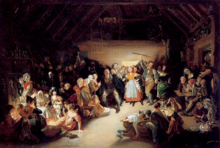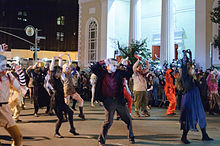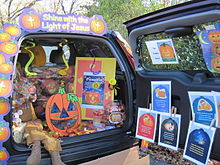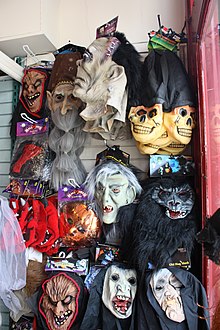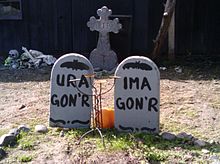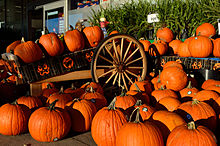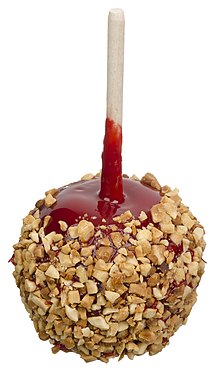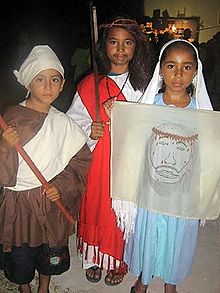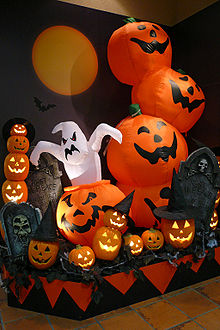Halloween
Halloween or Hallowe'en (less known as Allhalloween, All Hallows' Eve > or All Saints' Eve) is a holiday celebrated on October 31, the eve of the Western Christian feast of All Saints. Begins the observance of Allhallowtide, the time of the liturgical year dedicated to remembering the dead, including saints, martyrs, and all the faithful departed.
One theory holds that many Halloween traditions were influenced by Celtic harvest festivals, particularly the Gaelic festival of Samhain, which is believed to have pagan roots. Some go further, suggesting that Samhain it could have been Christianized as All Saints' Day, along with its eve, by the early Church. Other scholars believe that Halloween began solely as a Christian holiday, being the All Saints' Day Vigil. Celebrated in Ireland and Scotland for centuries, Irish and Scottish immigrants brought many Halloween customs to North America in the 19th century, and then, under American influence, Halloween spread to other countries in the late 20th century and early XXI.
Popular Halloween activities include trick-or-treating (or related guising and souling), attending Halloween costume parties, carving pumpkins or turnips in the shape of Jack-o'-lanterns, building bonfires, playing apple bite, guessing games, playing pranks, visiting haunted attractions, telling scary stories, and watching horror or Halloween-themed movies. Some people practice the Christian religious observances of All Hallows' Eve, such as attending religious services and lighting candles at the graves of the deceased, although for others it is a secular celebration. Historically, some Christians they abstained from meat on All Hallows' Eve, a tradition reflected in the consumption of certain vegetarian foods on this vigil day, such as apples, potato pancakes, and soul pies.
Etymology
The word Halloween or Hallowe'en ('night of the Saints') is of Christian origin and comes from the Scottish form All Hallows' Eve (Halloween): even is the Scottish term for 'eve' or 'night' and contracts for e'en o een; over time, (All) Hallow(s) E(v)en became Hallowe'en. A term equivalent to All Hallows Eve is attested in Old English.
History
Christian origins and historical customs
Halloween is believed to be influenced by Christian beliefs and practices. The English word Halloween comes from All Hallows' Eve, which is the eve of the Christian holidays of All Saints, on November 1, and All Souls, on November 2. Since the time of the early Church, the main holidays of Christianity (such as Christmas, Easter and Pentecost) had vigils beginning the night before, as did All Hallows. These three days are collectively called Allhallowtide and are the time when Western Christians honor all saints and they pray for recently deceased souls who have not yet reached Heaven. Various churches held commemorations of all saints and martyrs on various dates, most in spring. > was celebrated on May 13, and on May 13, 609, Pope Boniface IV consecrated the Pantheon of Rome to Saint Mary and all the martyrs. Lemuralia, an ancient Roman festival of the dead, took place on that date.
In the 8th century, Pope Gregory III (731-741) founded an oratory at Saint Peter's for relics "of the holy apostles and of all saints, martyrs, and confessors". Some sources state that it was dedicated on November 1, while others say that it was on Palm Sunday in April 732. Circa the year 800, there is evidence that the churches of Ireland and Northumbria celebrated an All Saints' Feast on 1 November. Alcuin of York, a member of Charlemagne's court, may have introduced this date of 1 November into the empire. Frankish, and 835 became the official date of the Frankish empire. Some suggest that it was due to Celtic influence, while others suggest that it was a Germanic idea, although it is claimed that both Germanic and culturally Celtic people commemorated the dead at the beginning of winter. They may have considered it the most more suitable to do so, since it is a time of "death" in nature. It is also suggested that the change was made for "practical reasons, since Rome in summer could not accommodate the large number of pilgrims who flocked to it », and perhaps due to public health concerns regarding Roman fever, which claimed several lives during Rome's muggy summers.
By the late 12th century century, the holiday had evolved into Western Christian holy days of obligation and included traditions such as Ring the church bells for the souls in purgatory. It was also "the custom for black-robed town criers to parade through the streets, ringing a mournful-sounding bell and calling on all good Christians to remember the poor souls". It has been suggested that the Allhallowtide custom of baking and sharing pies of soul for all baptized souls is the origin of trick-or-treating. This custom dates back to the 15th century and was spread across England, Wales, Flanders, Bavaria and Austria. Groups of poor people, often children, went door to door during Allhallowtide collecting soul cookies in exchange for praying for the departed, especially for the souls of friends and relatives. of the donors. This was called souling. Soul cookies were also offered to the souls themselves to eat, or soulers acted as their representatives. as in the Lenten tradition of Easter buns, soul cookies were often marked with a cross, indicating that they were baked as alms. Shakespeare mentions souling in his comedy The Two noblemen of Verona (1593). At the time of souling, Christians carried "lanterns made of hollow turnips", which may have originally represented the souls of the dead; Jack-o'-lanterns were used to ward off evil spirits. In the XIX century, in Ireland In Flanders, Bavaria and Tyrol, on All Saints' Day and All Souls' Day, candles were lit in homes, called "lights of the soul", which served "to guide souls back to visit their earthly homes ». In many of these places, candles were also lit on graves on All Saints' Day. In Brittany, libations of milk were poured on the graves of relatives, or food was left on the table overnight for the souls. returning; a custom also found in Tyrol and some parts of Italy.
Christian minister Prince Sorie Conteh linked the wearing of costumes to a belief in vengeful spirits: "Traditionally it was believed that the souls of the deceased roamed the earth until All Saints' Day, and All Hallows' Eve it offered the dead one last chance to take revenge on their enemies before passing on to the other world. To avoid being recognized by any soul who might be seeking such revenge, people donned masks or costumes." In the Middle Ages, European churches that were too poor to display relics of martyred saints on Allhallowtide allowed worshipers to dress up as saints. Some Christians follow this custom on Halloween. Lesley Bannatyne believes this could be a Christianization of an earlier pagan custom. Many Christians in continental Europe, especially in France, believed "that once a year, on Halloween... In, the dead from church graveyards would rise for a wild and horrifying carnival" known as the Dance of the Macabre, which was often performed in church decorations. Christopher Allmand and Rosamond McKitterick write in The New Cambridge Medieval History that the Dance of the Macabre urged Christians "not to forget the end of all earthly things". The Dance of the Macabre was performed sometimes in European village parades and court masques, where people "dressed up as corpses from various strata of society", and this may be the origin of Halloween costume parties.
In Britain, these customs came under attack during the Reformation, when Protestants branded purgatory as a "popish" doctrine incompatible with the Calvinist doctrine of predestination. State ceremonies relating to the intercession of saints and prayers for souls in purgatory were abolished during the Elizabethan Reformation, although All Saints' Day was retained in the English liturgical calendar to "commemorate the saints as pious human beings". For some maverick Protestants, the theology of Halloween was redefined; “Souls cannot be traveling from purgatory on their way to heaven, as Catholics often believe and assert. Instead, it is believed that so-called ghosts are actually evil spirits." Other Protestants believed in an intermediate state known as Hades (Limbo of the Patriarchs). In some localities, Catholics and Protestants continued to hold wakes, processions to the candlelight or ringing church bells for the dead; the Anglican Church eventually abolished these bell tolls. Mark Donnelly, professor of medieval archaeology, and historian Daniel Diehl write that "barns and houses were they blessed to protect people and livestock from the effect of witches, who were believed to accompany evil spirits on their journey across the land." After 1605, Hallowtide was eclipsed in England by Guy Fawkes Night (5 November), which appropriated some of their customs. In England, the end of official ceremonies related to the intercession of saints led to the development of new unofficial customs It's from Halloween. In rural Lancashire in the 18th century and XIX, Catholic families gathered in the hills on All Saints' Eve. One of them held a burning bundle of straw on a gallows while the rest knelt around him, praying for the souls of relatives and friends until the flames died down. This was known as teen'lay. There was a similar custom in Hertfordshire, and the lighting of tindle bonfires in Derbyshire. Some suggest that these tindles were originally lit to "guide poor souls back to the land". In Scotland and Ireland the ancient customs of Allhallowtide that were at odds with Reformed teachings were not suppressed, as they "were important to the life cycle and rites of passage of local communities" and their suppression would have been difficult.
In some parts of Italy, up until the 15th century, families left food for the ghosts of their relatives before attend religious services. In Italy in the 19th century, churches organized "theatrical performances of scenes from the life of saints" on All Saints' Day, with "participants represented by realistic wax figures". arranged around a waxen statue of an angel pointing heavenward. In the same country, "parish priests went from house to house, asking for small gifts of food which they shared among themselves throughout the night". Spain, the so-called Huesos de Santo are still baked and placed on the graves. In the cemeteries of In Spain and France, as well as in Latin America, priests lead processions and Christian services during Allhallowtide, after which people watch all night.:lowercase">XIX, in San Sebastián, a procession to the city cemetery was held during Allhallowtide, attended by beggars who "appealed to the tender memories of deceased relatives and friends" in search of compassion.
Influence of Gaelic folklore
Modern customs of Halloween are believed to be influenced by the folk customs and beliefs of Celtic nations, some of which have pagan roots. Folklorist Jack Santino writes that "throughout Ireland there was an uneasy truce between customs and beliefs associated with Christianity and those associated with religions that were Irish before the advent of Christianity". The origins of Halloween customs are often linked to the Gaelic festival of Samhain.
Samhain is one of the four seasonal festivals in the medieval Gaelic calendar and has been celebrated from October 31 to November 1 in Ireland, Scotland and the Isle of Man. The British Celts celebrated a similar holiday, called Calan Gaeaf in Wales, Kalan Gwav in Cornwall and Kalan Goañv in Brittany, a name meaning "first day of winter". For the Celts, the day ended and began at sunset, so the festival begins on the eve of November 1, according to modern reckoning. Samhain is mentioned in some of the earliest Irish literature. Historians have used these names to refer to Celtic Halloween customs up to the 19th century, and they remain the Gaelic names. and Welsh Halloween.
Samhain marked the end of the harvest season and the beginning of winter or the "darkest half" of the year. It was considered a liminal time, when the border between this world and the Otherworld blurred. This meant that the Aos Sí, the "spirits" or "fairies", could more easily enter this world and were especially active. Most scholars consider them "degraded versions of the old gods [...] whose This power remained active in the minds of the people even after it had been officially superseded by later religious beliefs". They were both respected and feared, and individuals often invoked God's protection when approaching their abodes. On Samhain the Aos Sí were appeased to ensure the survival of the people and livestock during the winter. Offerings of food and drink, or portions of the crops, were left for them. It was also said that the souls of the dead returned to their homes in search of hospitality. A place was reserved for them at the table and by the fire to welcome them. The belief that the souls of the dead come home one night a year and must be appeased seems to have ancient origins and is found in many cultures. In 17th century Ireland XIX, «candles were lit and formal prayers were made for the souls of the dead. Then the food, drink and games began."
In Ireland and Great Britain, especially in Celtic-speaking regions, household festivals included rituals and fortune-telling games intended to predict the future, especially regarding death and marriage. Apples and nuts, and among the customs that were practiced were that of biting the apple, roasting nuts, crystalloscopy or looking in the mirror, molybdomancy or ovomancy, interpretation of dreams and others. Special bonfires were lit and rituals were held with them. Its flames, smoke and ashes were considered to have protective and purifying powers. In some places, torches lit on the bonfire were carried following the direction of the sun around houses and fields to protect them. The bonfires are believed to have been a kind of sympathetic magic: they imitated the Sun and curbed the decay and darkness of winter. They were also used for divinatory purposes and to ward off evil spirits. In Scotland, bonfires and fortune-telling games were prohibited by the elders of some parishes. In Wales, bonfires were also lit to "keep the souls of the dead from falling to the ground". Later, these bonfires "keep the devil away".
At least as far back as the 16th century, the festival included mumming and guising in Ireland, Scotland, the Isle of Man and Wales. People went from house to house in costume, usually reciting verses or songs in exchange for food. It may have originally been a tradition whereby people impersonated the Aos Sí, or the souls of the dead, and received offerings in their name, something akin to souling. It was also believed that impersonating these beings, or wearing a disguise, served to protect oneself from them. In some parts of southern Ireland, guisers included a little horse. A man dressed as a Láir Bhán (white mare) would take young people from house to house reciting verses—some of them with pagan connotations—in exchange for food. If the household donated food, he could expect good luck from Muck Olla; failure to do so would bring misfortune. In Scotland, young men went from house to house with their faces masked, painted or blackened, often threatening mischief if they were not well received. Florence Marian McNeill suggests that the ancient festival it included costumed people representing spirits, whose faces were scarred or blackened with ashes from the sacred bonfire. In some parts of Wales, men were dressed as fearsome beings called gwrachod. Late 19th century and early XX, young men from Glamorgan and Orkney cross-dressing.
In other parts of Europe, mumming was part of other festivals, but in Celtic-speaking regions it was "particularly appropriate for a night when supernatural beings were said to be in the outside and could be imitated or chased away by wandering humans". » was synonymous with playing pranks in Ireland and the Scottish Highlands. The use of costumes and pranks at Halloween did not spread to England until the 20th century. like lanterns, often carved with grotesque faces. Makers said they represented spirits or served to ward off evil spirits. In the 17th century XIX were common in parts of Ireland and the Scottish Highlands, as well as Somerset. In the 20th century they spread to other parts of Britain and became known as jack-o'-lanterns.
Broadcast in North America
Lesley Bannatyne and Cindy Ott write that Anglican colonists in the southern United States and Catholics in Maryland "recognized Halloween in their church calendars", although Puritans in New England strongly opposed it. holiday, along with other traditional celebrations of the established Church, including Christmas. from the XIX do not indicate that Halloween was widely celebrated in North America.
It wasn't until after the mass immigration of the Irish and Scots in the 19th century that Halloween became a holiday important in the United States. Most American Halloween traditions were inherited from the Irish and Scottish, although "in Cajun areas, a night mass was said in cemeteries on Halloween night. Blessed candles were placed on the graves, and sometimes families would spend the whole night with them." At first it was limited to these immigrant communities, but gradually it became assimilated into society and by the turn of the century XX was celebrated from coast to coast by people of all social, racial, and religious backgrounds. By the turn of the century XX and early XXI, for American influence, these Halloween traditions spread to many other countries, including continental Europe and some parts of the Far East.
Symbols
The development of artifacts and symbols associated with Halloween took shape over time. Traditionally, on All Hallows' Eve, guisers carry Jack-o'-lanterns to scare away evil spirits. -lantern which, according to folklore, represents a "soul denied entry to both heaven and hell":
On his way home after a night of drinks, Jack meets the Devil and deceives him into a tree. Jack, quickly thoughtful, records the sign of the cross in the cortex, thus catching the Devil. Jack agrees that Satan will never be able to claim his soul. After a life of sin, drink and beggar, Jack is denied entry to heaven when he dies. By fulfilling his promise, the Devil refuses to let Jack in hell and throws a live coal directly from the flames of hell. It was a cold night, so Jack puts the coal in a hollow nap to prevent it from turning off, ever since Jack and his flashlight wandering around looking for a place to rest.
In Ireland and Scotland, a turnip was traditionally carved during Halloween, but immigrants to North America used the native pumpkin, which is much softer and larger, making it easier to carve than the turnip. pumpkin carving is documented in 1837 and was originally associated with harvest time in general, not specifically being associated with Halloween until the mid to late century XIX.
Modern Halloween imagery derives from many sources, including Christian eschatology, national customs, works of gothic and horror literature (such as the novels Frankenstein or modern Prometheus and Dracula) and classic horror films such as Frankenstein (1931) and The Mummy (1932). The image of the skull, a reference to Golgotha in the Christian tradition, serves as a "reminder of death and transience of human life" and, therefore, it is found in compositions of memento mori and vanitas; for this reason, skulls have been common in Halloween, which is dealt with in this theme. Traditionally, the back walls of churches "are decorated with a representation of the Last Judgment, with tombs opening and the dead rising, with a heaven full of angels and a hell full of demons", a motif that has permeated the celebration of Allhallowtide. One of the earliest works on the subject of Halloween is by the poet Scottish aunt John Mayne, who, in 1780, took note of the pranks on Halloween: What fearfu' pranks ensue!, as well as the supernatural associated with the night, the bogles (ghosts), which influenced Robert Burns' Halloween (1785). Elements of the autumn season also predominate, such as pumpkins, corn leaves and scarecrows, common in the decoration of houses. Halloween imagery includes themes of death, evil, and mythical monsters. Black cats, long associated with witches, are also a common symbol of Halloween. Black, orange, and sometimes purple are the traditional colors for Halloween.
Trick or treating and guising
Trick-or-treating (trick-or-treating) is a common custom for children on Halloween. They go from house to house in disguise, asking for treats such as candies or sometimes money, with the question “Trick or treat?”. The word "trick" (trick) implies a "threat" to do some mischief to the homeowners or their property if they are not given a treat. This practice is said to have its roots in the medieval practice of mumming, closely related to souling. John Pymm wrote that "many of the festivals associated with the performance of plays of mumming > were celebrated by the Christian Church". Among these holidays were All Saints' Eve, Christmas, Twelfth Night and Shrove Tuesday. The mumming, practiced in Germany, Scandinavia and other parts of Europe, consisted of masked and costumed people who "paraded through the streets and entered houses to dance or play dice in silence".
In England, from medieval times until the 1930s, people practiced the Christian custom of souling on Halloween, which consisted of groups of people, both Protestants and Catholics, they went from parish to parish, begging the rich soul cakes, in exchange for praying for the souls of the donors and their friends. In the Philippines, the practice of souling is called Pangangaluluwa and is practiced in Halloween among children in rural areas. People cover themselves in white cloth to represent souls and then visit homes, where they sing in exchange for prayers and sweets.
In Scotland and Ireland, guising—costumed children going door-to-door in exchange for food or coins—is a traditional Halloween custom. Halloween in 1895, costumed people carrying turnip lanterns would visit houses to be rewarded with cakes, fruit and money. In Ireland, the most popular phrase shouted by children (until the 2000s) was Help the Halloween Party. The practice of guising on Halloween in North America was first recorded in 1911, when a newspaper in Kingston, Ontario (Canada), reported that children were making guising around the neighborhood.
American historian and writer Ruth Edna Kelley wrote the first book on the history of Halloween in the United States, The Book of Hallowe'en (1919), and references souling in the chapter "Hallowe'en in America". which must have been in his best days overseas. All of the Halloween customs in the United States are direct borrowings or adaptations of those of other countries."
While the first reference to guising in North America occurs in 1911, another reference to ritual begging on Halloween appears, at an unknown location, in 1915, with a third reference in Chicago in 1920. The first known print use of the term trick or treat appears in 1927, in the Blackie Herald, Alberta, Canada.
The thousands of Halloween postcards produced between the early 20th century and the 1920s often feature children, but not trick-or-treating. This does not appear to have become a widespread practice in North America until the 1930s, with the term's first appearances in the United States in 1934, and its first use in a national publication in 1939.
A popular variant of trick-or-treating, known as trunk-or-treating (or Halloween tailgating), occurs when "kids are offered Halloween candy." the trunks of cars parked in a church parking lot", or sometimes, in a school parking lot. At a trunk-or-treating event, the trunk of each car is decorated with a given theme, such as those in children's literature, movies, scriptures, and job roles. The trunk-or-treat has gained popularity because it is considered safer than going door-to-door. door, something that parents like very much, and because it "solves the rural problem of houses built half a mile away".
Costumes
Traditionally, Halloween costumes were modeled after figures such as vampires, ghosts, skeletons, scary-looking witches, and ghouls. Over time, the selection of costumes expanded to include popular fictional characters, celebrities, and archetypes. generic like ninjas and princesses.
Dressing up costumes and going guising was widespread in Scotland and Ireland on Halloween at the turn of the century XIX. The tradition, of Scottish origin, is called guising for the costumes or costumes worn by children. In Ireland and Scotland, the masks are known as false faces , a term recorded in Ayr (Scotland) in 1890 by a Scotsman describing guisers: "I had mind it was Halloween... the wee callans were at it already, rinning aboot wi' their fause-faces (false faces) on and their bits o' turnip lanthrons (lanterns) in their haun (hand). lowercase">XX, for both adults and children, and when trick-or-treating became popular in Canada and the US in the 1920s and 1930s.
Eddie J. Smith, in his book Halloween, Hallowed is Thy Name, offers a religious perspective on costume-wearing on Halloween, suggesting that by dressing up as creatures "that in they once made us fear and tremble," people can mock Satan "whose kingdom has been plundered by our Savior." Images of skeletons and the dead are traditional ornaments used as memento mori.
Trick-or-Treat for UNICEF is a fundraising program to support UNICEF, a United Nations program that provides humanitarian aid to children in developing countries. Started as a local event in a Northeast Philadelphia neighborhood in 1950 and expanded nationally in 1952, the program involves the distribution of small boxes by schools (or, in modern times, sponsoring companies such as Hallmark, in their authorized stores) to children trick-or-treating, where they can request donations of money in the houses they visit. It is estimated that the children have raised more than 118 million dollars for UNICEF since its creation. In Canada, in 2006, UNICEF decided to discontinue its Halloween collection boxes, citing administrative and security problems; after consulting with the schools, he instead redesigned the program.
New York's annual Village Halloween Parade began in 1974; It is the largest Halloween parade in the world and the only major nighttime parade in the United States, attracting more than 60,000 costumed participants, two million spectators, and a global television audience.
Since the late 2010s, ethnic stereotypes as costumes have come under increasing scrutiny in the United States. These and other potentially offensive costumes have drawn increasing public disapproval.
Games and other activities
There are several games traditionally associated with Halloween. Some of these games originated as divination rituals or ways to predict the future, especially in regards to death, marriage, and children. During the Middle Ages, these rituals were performed by "a few" in rural communities, as they were considered "deadly serious" practices. In recent centuries, these fortune-telling games have been "a common feature of domestic festivals". in Ireland and Great Britain. They usually involve apples and hazelnuts. In Celtic mythology, apples were closely associated with the Otherworld and immortality, while hazelnuts were associated with divine wisdom. Some also suggest that they derive from Roman Pomona celebratory practices.
The following activities were common on Halloween in Ireland and Great Britain from the 17th to XX. Some have spread and are still popular. A common game is apple biting or dunking (which in Scotland may be called dooking), in which apples float in a tub or large basin of water and the Participants must use only their teeth to remove an apple from the bowl. A variant of dunking involves kneeling on a chair, holding a fork between your teeth, and trying to stick it into an apple. Another common game involves hanging molasses- or syrup-coated scones on strings; they have to be eaten without using their hands while attached to the rope, an activity that inevitably leads to a sticky face. Another once popular game involves hanging from the ceiling, at head height, a small wooden rod with a lighted candle at one end and an apple hanging from the other. The rod is spun and everyone takes turns trying to catch the apple with their teeth.
Several of the traditional activities of Ireland and Great Britain consist of predicting the future partner or spouse. An apple is peeled in a long strip and the peel is thrown over the shoulder. The shell is believed to be in the shape of the first letter of the name of the future spouse. Two hazelnuts are roasted near the fire, one with the name of the person roasting them and the other with that of the desired person. If the hazelnuts jump due to the heat, it is a bad sign, but if they are toasted calmly, it augurs a good couple. A salty oatmeal bannock would be baked; the person would eat it in three bites and then go to bed quietly without anything to drink. This is said to trigger a dream in which her future spouse offers her a drink to quench her thirst. Single women were told that if they sat in a dark room and looked in a mirror on the night of Halloween, the face of her future husband would appear in the mirror. The custom became widespread enough to be commemorated on greeting cards from the turn of the century XIX and early XX.
Another popular Irish game was púicíní ('blindfolded'); a person was blindfolded and chose between various dishes. The object on the saucer gave a clue to his future: a ring meant that she would marry soon; the clay, which would die soon, perhaps in a year; the water, which would migrate; the beads of the rosary, which would take the habit (nun, priest, monk, etc.); a coin, which would become rich; a bean, which would be poor. The game figures prominently in James Joyce Clay's short story (1914).
In Ireland and Scotland, objects were hidden in the food—usually a pie, barmbrack, cranachan, champ, or colcannon—and portions were served at random. For example, a ring meant marriage and a coin meant wealth.
Until the 19th century, Halloween bonfires were also used for divination in parts of Scotland, Wales and Brittany. When the fire was extinguished, a ring of stones was placed in the ashes, one for each person. In the morning, if any stone was lost, it was said that the person it represented would not survive the year.
Haunted Rides
Haunted attractions are entertainment venues designed to thrill and frighten patrons. Most of the attractions are seasonal Halloween businesses that can include haunted houses, corn mazes, and hayrides, and the level of sophistication of the effects has increased as the industry has grown.
The first recorded haunted attraction was the Orton and Spooner Ghost House, opened in 1915 in Liphook, England. Actually, this attraction is more like a funhouse, powered by steam. The house still exists, in the Hollycombe Steam Collection.
It was in the 1930s, around the same time as trick-or-treating, that Halloween-themed haunted houses began to appear in America, and it was in the late 1950s that Halloween-themed haunted houses began to appear. haunted houses as the main attraction, focusing first on California. Sponsored by the Children's Health Home Junior Auxiliary, the San Mateo Haunted House opened in 1957, with the San Bernardino Assistance League Haunted House opening the following year. In 1962 and 1963 haunted houses began to appear all over the country. In 1964 the San Manteo Haunted House and the Children's Museum Haunted House in Indianapolis opened.
The haunted house as an American cultural icon can be attributed to the opening of The Haunted Mansion at Disneyland on August 12, 1969. Knott's Berry Farm began hosting its own Halloween nighttime attraction, Knott's Berry Farm. s Scary Farm, which opened in 1973. Evangelical Christians took a form of these attractions by opening one of the first "hell houses" in 1972.
The first non-profit Halloween haunted house was organized in 1970 by the Jaycees of Sycamore-Deer Park in Clifton, Ohio. It was co-sponsored by WSAI, an AM radio station broadcasting from Cincinnati, Ohio. It was last produced in 1982. Other Jaycees followed suit with their own versions following the success of the Ohio house. The March of Dimes copyrighted a "March of Dimes Mini Haunted House" in 1976 and soon after began raising funds through its local chapters by performing haunted houses. Although they apparently stopped supporting such events on a national scale sometime in the 1980s, some March of Dimes haunted houses have endured to this day.
On the night of May 11, 1984, in Jackson Township, New Jersey, the Haunted Castle (Six Flags Great Adventure) caught fire. Eight teenagers died as a result of the fire. The tragedy led to a tightening of safety regulations, building codes, and the frequency of ride inspections across the country. Smaller venues, especially not-for-profit attractions, were unable to compete financially, and better-funded commercial enterprises filled the void. Venues that previously could evade regulations as temporary facilities now had to comply with higher codes. strict requirements for permanent attractions.
In the late 1980s and early 1990s, theme parks got into business in earnest. Six Flags Fright Fest began in 1986 and Universal Studios Florida started Universal's Halloween Horror Nights in 1991. Knott's Scary Farm experienced a surge in attendance in the 1990s as a result of America's obsession with Halloween as a cultural event. Theme parks have played a pivotal role in the globalization of the party. Universal Studios Singapore and Universal Studios Japan participate in it, while Disney organizes Mickey's Not-So-Scary Halloween Party in its parks in Paris, Hong Kong and Tokyo, as well as in the United States. theme parks are by far the largest, both in scale and attendance.
Food
On All Hallows' Eve, many Western Christian denominations encourage abstinence from meat, leading to a variety of vegetarian foods being associated with this day.
Since Halloween coincides with the annual apple harvest in the Northern Hemisphere, caramel apples (known as toffee apples outside of North America), candy apples, or taffy apples are common Halloween treats made by rolling whole apples into a sticky sugar syrup, sometimes followed by dried fruit.
Caramel apples were once commonly given to children trick-or-treating, but this practice quickly died out following widespread rumors that individuals were embedding objects such as pins and razor blades into apples in the United States United States. Although there is evidence of such incidents, actual cases of malicious acts are extremely rare and have never resulted in serious injury. However, many parents took it for granted that such egregious practices were proliferating thanks to the media. At the height of the hysteria, some hospitals offered free X-rays of children's Halloween batches to find evidence of tampering. Virtually all known incidents of candy poisoning have resulted from parents poisoning their own children's candy.
A custom that persists in Ireland is to bake (or, more often, buy) a barmbrack (Irish: báirín breac), which is a fruit cake in which are placed a ring, a coin and other charms before baking it. The one who finds it is considered lucky. It is also said that whoever receives a ring will find his true love in the following year. It is a tradition similar to that of the Roscón de Reyes.
List of foods associated with Halloween:
- Barmbrack (Ireland)
- Bonfire toffee (Great Britain)
- Candy Apple (Great Britain and Ireland)
- Candy apple, sweet corn, sweet pumpkin (North America)
- Chocolate
- Peanuts (Ireland and Scotland)
- Sweet apple
- Caramelized Maize
- Colcannon (Ireland)
- Halloween tart
- Candy shaped like a skull, pumpkin, bat, worm, etc.
- Toasted pumpkin seeds
- Sweet maize toast
- Soul pie
- Pumpkin pie
Christian religious observances
In Poland, on Hallowe'en (All Saints' Eve), believers were taught to pray aloud while walking through the woods for the souls of the dead to find solace; in Spain, priests from smaller towns ring their church bells to remind their faithful to remember the dead. In Ireland, and among immigrants from Canada, a custom includes the Christian practice of abstinence, keeping All Hallows Eve as a day without meat and serving pancakes or colcannon instead. In Mexico, children make an altar to invite the return of the spirits of dead children (angelitos).
Traditionally, the Christian Church celebrated Halloween by holding a vigil. The faithful prepared for the feast of All Saints' Day with prayers and fasting. This church service is known as All Saints' Vigil; an initiative known as Night of Light tries to extend the Vigil of All Saints throughout Christendom. After the mass, "appropriate feasts and entertainments" are usually held, as well as a visit to the cemetery, where flowers and candles are often placed in preparation for All Saints' Day In Finland, due to the large number of people who flock to cemeteries on All Hallows' Eve to light votive candles, "they are known as valomeri, or seas of light".
Modern Christian attitudes toward Halloween are diverse. In the Anglican Church, some dioceses have chosen to emphasize Christian traditions associated with All Hallows' Eve. Some of these practices include prayer, fasting, and attendance at religious services.
We beseech thee, Lord, our God, that thou mayest increase and multiply upon us the gifts of thy grace, that, by preventing the glorious feast of all thy saints, we may follow them with joy in every virtuous and godly life. By Jesus Christ, our Lord, who lives and reigns with you, in the unity of the Holy Spirit, for the centuries. Amen. —Collect of the Vigil of All Saints, Anglican Breviary.
Other Protestant Christians also celebrate Halloween as Reformation Day, a day to remember the Protestant Reformation, along with or independently of Halloween. This is because it is said that Martin Luther posted his Ninety-Five Theses on All Saints' Church in Wittenberg on All Hallows' Eve. children dress up as biblical characters or Reformers. In addition to distributing candy to children trick-or-treating on Halloween, many Christians also give them Gospel tracts. One organization, the American Tract Society, claims that some three million gospel tracts are ordered for Halloween celebrations alone. Others order Halloween Scripture candy to hand out to children.
Some Christians are concerned about the modern celebration of Halloween because they believe it trivializes—or celebrates—paganism, the occult, and other cultural practices and phenomena considered incompatible with their beliefs. Father Gabriele Amorth, an exorcist in Rome, has said that “if English and American children like to dress up as witches and devils one night a year, no problem. If it's just a game, there's nothing wrong with it." In more recent years, the Catholic Archdiocese of Boston has hosted a Halloween Feast of All Hallows. Similarly, many contemporary Protestant churches view Halloween as a fun event. for children, holding events in their churches where children and their parents can dress up, play games and get candy. For these Christians, Halloween poses no threat to the spiritual life of children: being taught about death and mortality, and the customs of Celtic ancestors is actually a valuable life lesson and part of the heritage of many of his parishioners. Christian minister Sam Portaro wrote that Halloween is about using "humor and ridicule to confront the power of death".
Halloween's Christian connection is recognized in the Catholic Church, and Halloween celebrations are common in many Catholic parochial schools in the United States. popularity of Halloween as an opportunity for evangelism. Others consider Halloween to be totally incompatible with the Christian faith due to its supposed origins in the celebration of the Festival of the Dead. In fact, although Eastern Orthodox Christians celebrate All Saints' Day on the first Sunday after Pentecost, the Eastern Orthodox Church recommends the celebration of Vespers or a Paraklesis in the Western celebration of All Hallows' Eve, out of the pastoral need to offer an alternative to popular celebrations.
Similar celebrations and perspectives
Judaism
According to Alfred J. Kolatch in the Second Jewish Book of Why, in Judaism Halloween is not permitted by Jewish Halacha because it violates Leviticus 18:3, which prohibits Jews from participating in Gentile customs. Many Jews celebrate Yizkor communally four times a year, which is vaguely similar to the Allhallowtide observance in Christianity, in that one prays for "the martyrs as well as one's own family". However, many American Jews they celebrate Halloween, disconnected from their Christian origins. Reform Rabbi Jeffrey Goldwasser has stated that "there is no religious reason why contemporary Jews should not celebrate Halloween", while Orthodox Rabbi Michael Broyde has opposed Jews celebrate this holiday. Purim has sometimes been compared to Halloween, in part because some observants wear costumes, especially those of Biblical figures described in the Purim account.
Islamic
Sheikh Idris Palmer, author of A Brief Illustrated Guide to Understanding Islam, has ruled that Muslims should not participate in Halloween, stating that "participating in Halloween is worse than participating in Christmas, Easter,... is more sinful than congratulating Christians on their prostration before the crucifix". humorous mixed with horror to entertain and resist the spirit of death influencing humans". Dar Al-Ifta Al-Missriyyah disagrees, as long as the celebration is not called "Eid" and the behavior conforms to Islamic principles.
Hinduism
Hindus remember the dead during the Pitru Paksha festival, during which they pay homage and perform a ceremony "to keep the souls of their ancestors at rest." It is celebrated in the Hindu month of Bhadrapada, usually in mid-September. The celebration of the Hindu festival Diwali sometimes conflicts with the date of Halloween, but some Hindus choose to participate in popular Halloween customs. Other Hindus, such as Soumya Dasgupta, have opposed the celebration, claiming that Western holidays such as Halloween "have started to negatively affect our native holidays".
Neopaganism
There is no consistent rule or point of view about Halloween among those who describe themselves as Neopagans or Wiccans. Some Neopagans do not celebrate Halloween, but instead celebrate Samhain on November 1. Some Neopagans enjoy the festivities of Halloween, stating that one can celebrate both "the solemnity of Samhain and the fun of Halloween". Other Neopagans oppose the celebration of Halloween, stating that it "trivializes Samhain", and "avoid Halloween, due to interruptions from trick-or-treaters". The Manitoban writes that " Wiccans don't officially celebrate Halloween, even though October 31st is still on any good Wiccan's agenda. Starting at sunset, Wiccans celebrate a holiday known as Samhain. Actually, Samhain stems from ancient Celtic traditions and is not exclusive to Neopagan religions like Wicca. Although the traditions of this holiday have their origins in Celtic countries, today's Wiccans do not attempt to historically reproduce the celebrations of Samhain. Some traditional Samhain rituals are still practiced, but at its core, the period is treated as a time to celebrate the dark and the dead — a possible reason why Samhain can be confused with Halloween celebrations."
Geography
The traditions and importance of Halloween vary widely from country to country. In Scotland and Ireland, traditional Halloween customs include children dressing up, guising and having parties, while other practices in Ireland include lighting bonfires and firework displays. In Brittany, children would prank putting candles inside skulls in cemeteries to scare off visitors. /span> popularized Halloween in North America, and its celebration in the United States and Canada has had a significant impact on the way it is celebrated in other nations. This great North American influence, especially in the iconic and commercial elements, has extended to places like Brazil, Ecuador, Chile, Australia, New Zealand, (most of) continental Europe, Finland, Japan, and other parts of East Asia.
Contenido relacionado
Yuri (gender)
Urantia book
Fallas in Valencia




